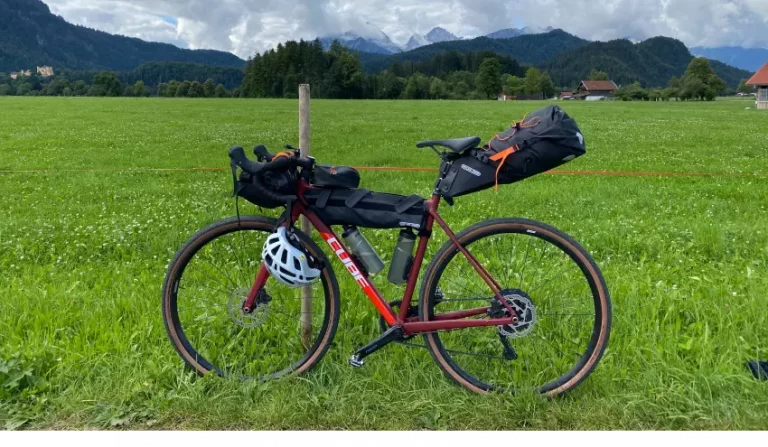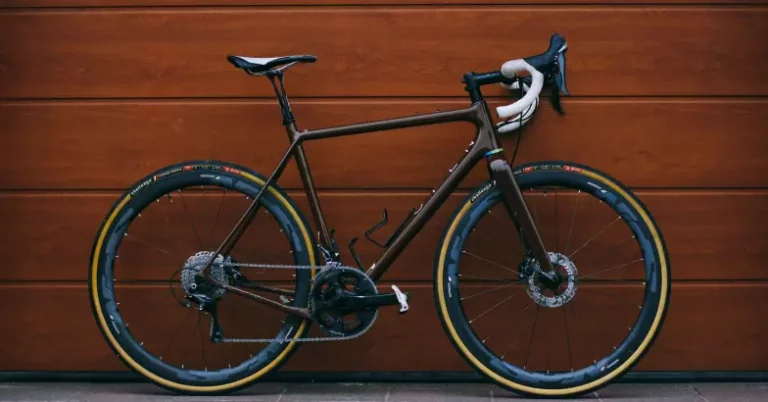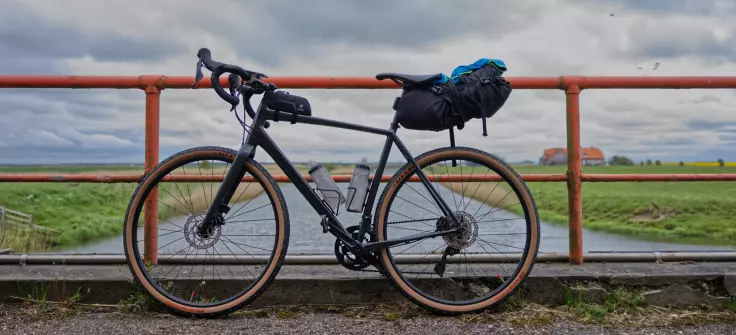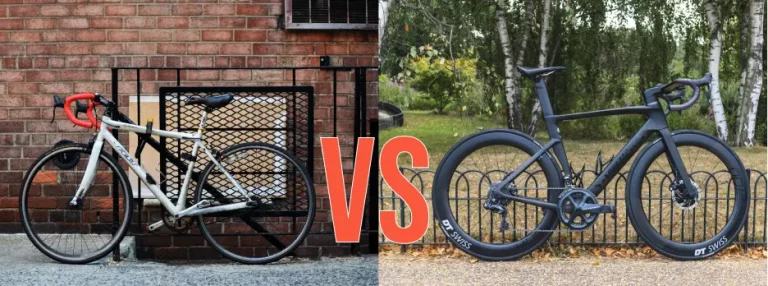9 Tips for Riding a Road Bike in the Rain!
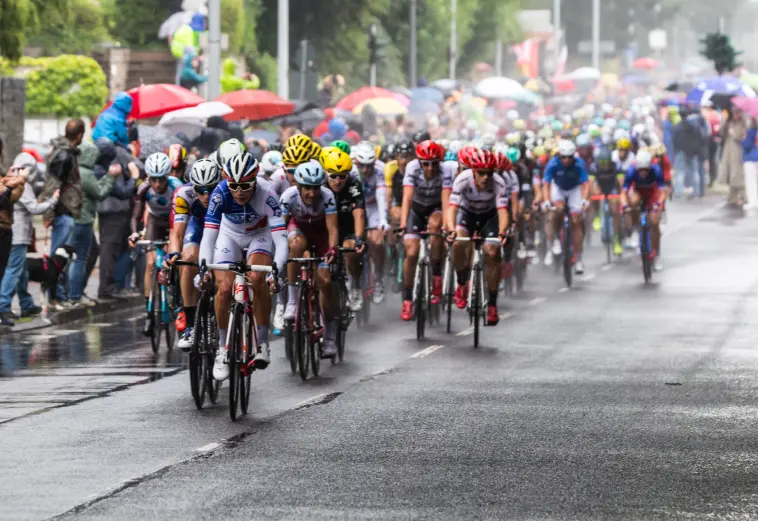
Does riding a road bike in rain scares you a little bit?
If the answer is yes, you’ve come to the right place. Because in this article I am going to reveal all the tips and tricks I’ve learned over the years of cycling in wet conditions.
Trust me, it’s not as hard as you might think.
Road cycling in the rain is very safe if you have the right gear and if you implement all the tips I am going to show you.
Sometimes I even prefer riding my road bike in the rain.
When that adrenalin hit kicks in, the best thing in the world.
But let’s get back to the topic.
Here are the 9 best tips on how to ride your road bike in the rain.
Table of Contents
1. Change Your Tires
Let’s first start with some tips to prepare your bike for those wet conditions so you can ride like you normally would on a dry road.
Your tires are very important, they are the contact point between your bike and the road. The more grip you have, the safer you will be on the wet road.
When it comes to choosing your tire, I will recommend getting a tire with plenty of treads and grip, preventing the water to go underneath your tire causing aquaplaning.
You want to avoid that at all costs. When the aquaplaning occurs you are literary done.
You can’t control your bike, you can’t brake, you are almost helpless.
That’s why you need to have some kind of grip on your tires.
You don’t need to go with 32mm off-road tires, but you can use all-season 25 or 28mm tires they are completely fine.
Tire width doesn’t really matter that much as long as you have a nice grip.
Also, they will have better puncture resistance, if it’s raining hard and you don’t have a clear vision they can save you from getting a flat tire.
2. Lube Your Chain
Another key part of your bike is the chain. You want to make sure your chain is in good condition even in the wet.
He is responsible for your speed so you have to pay him back.
You can do that by applying a specific wet lube all over your chain. Wet lube is designed to keep the water out and keep your chain nice and greasy even in the biggest rains.
Also, by keeping your chain clean and maintained, you will be able to extend its lifespan.
3. Rain Jacket is a Must
The last thing you want to do is get cold.
This will ruin your whole ride because when body temperature is down, your reaction time will be slower, your handling will not be as good, etc.
That’s why it’s essential to wear a rain cape.
Bonus tip: Wear a hat that has a peak, it will make your head nice and warm while preventing all the rain and dirt from getting into your eyes.
I always have a rain jacket near me, all year round, you never know when the rain will hit, especially if you live in the mountains, or in the UK.
The good thing is that you can easily bring it anywhere because it packs down to nothing in your back pocket.
4. Get Neoprene Gloves
Most beginner cyclists are falling into a big trap by using waterproof gloves, or even worse they are not using gloves at all.
That is a big mistake.
In my personal experience, these gloves don’t work at all. My hands still get cold like I am not even wearing them.
I am sure most of you have experienced that before.
That’s why I recommend getting yourself a good pair of neoprene gloves.
These gloves are designed specifically for wet conditions. Instead of blocking the water, these gloves trap the water in a tiny layer next to your skiing and worms it up.
I know it sounds confusing, but trust me it works like magic.
Your hands will finally be warm.
5. Brake Carefully
Now let’s move on to some advanced riding skills you may have not taught before.
As I said earlier I love riding in the rain because there is more skill involved. You need to know how to handle your bike, how to corner, and how to brake.
Let’s start first with some braking tips.
The biggest mistake I was making as a beginner is that I used to pull my brakes too hard like I was riding on a normal sunny day which is a huge mistake.
I almost fell into the river because of that.
If you slam on your brakes during rain, there is almost a 100% chance that you will skid.
So make sure you are gradually increasing the pressure so your wheels don’t lock up.
6. Don’t throw your bike into the corner
As I mentioned before, cornering in the rain is very hard, especially if you are a beginner cyclist.
Meaning you can’t just throw your bike into the corner or lean over as far as you would in dry conditions.
You just need to follow 3 simple rules when it comes to cornering in rain.
- Take a wider line than you normally would.
- Do not lean over
- Brake before the corner comes
7. Avoid White Lines
This one is really simple.
You need to avoid riding on any type of line on the roads, especially if they are recently painted.
In some countries in Europe these lines literary offer no grip at all, which means you can skid very easily as if you were cycling on the ice.
You want to pay close attention to avoid them, especially when you are braking and cornering.
8. Use Mud Guards
The next tip is to use mudguards on your bike.
They will block most of the water and dirt from splashing all over.
There is nothing worse than constantly getting sprayed with dirty water by someone in front.
This is a must especially if you are constantly riding in a group.
Also, your bike will be a lot cleaner and more importantly, when you stop to drink coffee you won’t have a wet bottom.
9. Increase Your Visibility
Probably the biggest mistake beginner cyclists are making is not being visible enough in the rain.
There are two ways to get more visible.
The first one is using lights. Even if it’s day outside, lights are essential when the rain starts kicking in.
Although in most countries there is not a specific law that you must use lights in the rain, I will highly recommend it for your own safety.
Especially rear lights, as soon as you feel one sip of the water on your skin, turn the rear light on.
When the rain becomes a heavy storm, you can turn on the front light as well.
The second way to increase your visibility during the rain is by wearing reflective clothing. Or at least wear bright colors like white, orange, and yellow.
With those clothes on you will be far more visible to other road users.
At least better than your black t-shirt.
I hope this article was helpful.

